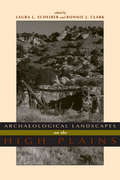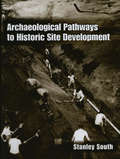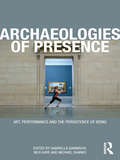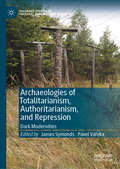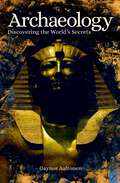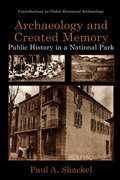- Table View
- List View
Archaeological Landscapes on the High Plains
by Bonnie J. Clark Laura L. ScheiberArchaeological Landscapes on the High Plains combines history, anthropology, archaeology, and geography to take a closer look at the relationships between land and people in this unique North American region. Focusing on long-term change, this book considers ethnographic literature, archaeological evidence, and environmental data spanning thousands of years of human presence to understand human perception and construction of landscape. The contributors offer cohesive and synthetic studies emphasizing hunter-gatherers and subsistence farmers. Using landscape as both reality and metaphor, Archaeological Landscapes on the High Plains explores the different and changing ways that people interacted with place in this transitional zone between the Rocky Mountains and the eastern prairies. The contemporary archaeologists working in this small area have chosen diverse approaches to understand the past and its relationship to the present. Through these ten case studies, this variety is highlighted but leads to a common theme - that the High Plains contains important locales to which people, over generations or millennia, return. Providing both data and theory on a region that has not previously received much attention from archaeologists, especially compared with other regions in North America, this volume is a welcome addition to the literature. Contributors: o Paul Burnett o Oskar Burger o Minette C. Church o Philip Duke o Kevin Gilmore o Eileen Johnson o Mark D. Mitchell o Michael R. Peterson o Lawrence Todd
Archaeological Pathways to Historic Site Development
by Stanley SouthIn this book I walk with the reader along the bothered me that some of my colleagues, in their archaeological pathways traveled by many reports of archaeological activity on documented researchers in the process of historic site historic sites, never mention finding evidence of previous American Indian occupation. Sites development. The sponsors, historians, archaeologists, and administrators who have selected by Europeans, usually on high ground bordering the deep water channel of navigatable traveled those pathways may find familiar much of what I say here. The pathways exploring the past streams, are those also once preferred by Native Americans for the access to environmental involve research in documents and the archaeological record, using the best methods of resources they afford. How could Native both, in an attempt to understand the material American material culture not be present on such culture remains left behind, not only by explorers sites? and colonists from Europe and Africa, but also by I once asked a well-known archaeological Native Americans who lived in the environment for colleague why it was that such evidence did not appear in his reports from such sites, and the reply millenia before those strangers appeared on the scene. In explaining the archaeological record of was, "Gh, I find all kinds of Indian things on the American Indians I lean on not only archaeological historic sites I dig, but that's not why I'm there.
Archaeological Practice as Politics and Ethics
by John CarmanThis book is of relevance to all archaeologists and all others concerned with how an interest in the past impacts on the present. This book explores the manner in which archaeology as a discipline and a field of endeavour contributes to the modern world. The focus throughout the book is on practices - the range of different things that archaeologists do and how they do and have done it in order to explore the field as a distinctive aspect of social practice over time. It also concerns the structures – social, political, economic, professional, philosophical – in which archaeology is performed and the consequences for the discipline and its practitioners. Throughout there is a concern especially with archaeology as a field of political and ethical decision-making, aspects well recognised by practitioners but rarely emphasised. The book both asks and answers questions about the perception of archaeology from both within and outside the field. The book draws widely on previous work by the author and others – looking at the techniques of the field, the people involved, the political and social impacts both on and by the field. In doing so it seeks to bring these different perspectives together to create a more holistic idea of what archaeology is, has been, and could be. The book is offered to those outside the field as a justification for archaeology – a field coming under increasing pressure from those who consider it (as so many humanities and social science disciplines) as an expensive luxury.
Archaeological Research on the Societies of Late Prehistoric Xinjiang, Vol 1
by Guo WuThis book presents cutting-edge archaeological materials from Xinjiang, from the Bronze Age to the early Iron Age. Through a systematic topological study of major archaeological cemeteries and sites, it establishes chronologies and cultural sequences for three main regions in Xinjiang, namely the circum-Eastern Tianshan region, the circum-Dzungarian Basin region and the circum-Tarim Basin region. It also discusses the origins and local variants of prehistoric archaeological cultures in these regions and the mutual relationships between them and neighboring cultures.By doing so, the book offers a panoramic view of the socio-cultural changes that took place in prehistoric Xinjiang from pastoral-agricultural societies to the mobile nomadic-pastoralist states in the steppe regions and the agricultural states of the oasis, making it a must-read for researchers and general readers who are interested in the archaeology of Xinjiang.
Archaeological Research on the Societies of Late Prehistoric Xinjiang, Vol 2
by Guo WuThis book presents cutting-edge archaeological materials from Xinjiang, from the Bronze Age to the early Iron Age. Through a systematic topological study of major archaeological cemeteries and sites, it establishes chronologies and cultural sequences for three main regions in Xinjiang, namely the circum-Eastern Tianshan region, the circum-Dzungarian Basin region and the circum-Tarim Basin region. It also discusses the origins and local variants of prehistoric archaeological cultures in these regions and the mutual relationships between them and neighboring cultures.By doing so, the book offers a panoramic view of the socio-cultural changes that took place in prehistoric Xinjiang from pastoral-agricultural societies to the mobile nomadic-pastoralist states in the steppe regions and the agricultural states of the oasis, making it a must-read for researchers and general readers who are interested in the archaeology of Xinjiang.
An Archaeological Study of Rural Capitalism and Material Life: The Gibbs Farmstead in Southern Appalachia, 1790-1920 (Contributions To Global Historical Archaeology)
by Mark D. GrooverHistorical archaeology has largely focused on the study of early military sites and homes of upper class. Research on lower classes was viewed as a supplement to local histories documenting political, military and financial leaders of the 18th and 19th centuries. An Archaeological Study of Rural Capitalism and Material Life will be of interest to historical archaeologists, cultural anthropologists, social historians, and historical sociologists, especially researchers studying the influence of globalization and economic development upon rural regions like Appalachia.
Archaeologies of Cultural Contact: At the Interface
by Timothy Clack Marcus BrittainArchaeologies of Cultural Contact undertakes an exploration of cultural transfer, with a particular focus on the combination and modification of both material and behavioural attributes under conditions of contact. From globalization and displacement to cultural legitimization and identity politics, the modern world is characterised by, and articulated through, dynamics of contact and transfer. This book recognises that creolization, ethnogenesis, hybridity, and syncretism are analytical concepts and social processes, relevant not only to the postcolonial contexts of the twentieth century but also to wide-ranging instances where contact is made between cultural groups. Indeed, in representing the re-working of pre-existing cultural elements, they were crucial and ever-present features of the human past. Ranging in their analytical frame, scale, and geographical and temporal location, the chapters in this volume demonstrate the diverse understandings that can be gained from explorations into the material remains of past contact, exposing and overcoming various limitations of competing models of cultural change. They permit insights into not only cultural change and difference but also the processes of appropriation, resistance, redefinition, and incorporation. Together, the contributions articulate the perspectives that concern practices in relations to people, places, and things, and note how power dynamics mediate social interactions and sustain and constrain forms of cultural contact. This book will be of interest to researchers and students in archaeology as well those from cognate disciplines, particularly anthropology and history.
Archaeologies of Cultural Contact: At the Interface
Archaeologies of Cultural Contact undertakes an exploration of cultural transfer, with a particular focus on the combination and modification of both material and behavioural attributes under conditions of contact. From globalization and displacement to cultural legitimization and identity politics, the modern world is characterised by, and articulated through, dynamics of contact and transfer. This book recognises that creolization, ethnogenesis, hybridity, and syncretism are analytical concepts and social processes, relevant not only to the postcolonial contexts of the twentieth century but also to wide-ranging instances where contact is made between cultural groups. Indeed, in representing the re-working of pre-existing cultural elements, they were crucial and ever-present features of the human past. Ranging in their analytical frame, scale, and geographical and temporal location, the chapters in this volume demonstrate the diverse understandings that can be gained from explorations into the material remains of past contact, exposing and overcoming various limitations of competing models of cultural change. They permit insights into not only cultural change and difference but also the processes of appropriation, resistance, redefinition, and incorporation. Together, the contributions articulate the perspectives that concern practices in relations to people, places, and things, and note how power dynamics mediate social interactions and sustain and constrain forms of cultural contact. This book will be of interest to researchers and students in archaeology as well those from cognate disciplines, particularly anthropology and history.
Archaeologies of Presence
by Gabriella Giannachi Nick Kaye Michael ShanksArchaeologies of Presence is a brilliant exploration of how the performance of presence can be understood through the relationships between performance theory and archaeological thinking. Drawing together carefully commissioned contributions by leading international scholars and artists, this radical new work poses a number of essential questions: What are the principle signifiers of theatrical presence? How is presence achieved through theatrical performance? What makes a memory come alive and live again? How is presence connected with identity? Is presence synonymous with 'being in the moment'? What is the nature of the ‘co-presence’ of audience and performer? Where does performance practice end and its documentation begin? Co-edited by performance specialists Gabriella Giannachi and Nick Kaye, and archaeologist Michael Shanks, Archaeologies of Presence represents an innovative and rewarding feat of interdisciplinary scholarship.
Archaeologies of Presence
by Gabriella Giannachi Nick Kaye Michael ShanksArchaeologies of Presence is a brilliant exploration of how the performance of presence can be understood through the relationships between performance theory and archaeological thinking. Drawing together carefully commissioned contributions by leading international scholars and artists, this radical new work poses a number of essential questions: What are the principle signifiers of theatrical presence? How is presence achieved through theatrical performance? What makes a memory come alive and live again? How is presence connected with identity? Is presence synonymous with 'being in the moment'? What is the nature of the ‘co-presence’ of audience and performer? Where does performance practice end and its documentation begin? Co-edited by performance specialists Gabriella Giannachi and Nick Kaye, and archaeologist Michael Shanks, Archaeologies of Presence represents an innovative and rewarding feat of interdisciplinary scholarship.
Archaeologies of Remembrance: Death and Memory in Past Societies
by Howard WilliamsHow did past communities and individuals remember through social and ritual practices? How important were mortuary practices in processes of remembering and forgetting the past? This innovative new research work focuses upon identifying strategies of remembrance. Evidence can be found in a range of archaeological remains including the adornment and alteration of the body in life and death, the production, exchange, consumption and destruction of material culture, the construction, use and reuse of monuments, and the social ordering of architectural space and the landscape. This book shows how in the past, as today, shared memories are important and defining aspects of social and ritual traditions, and the practical actions of dealing with and disposing of the dead can form a central focus for the definition of social memory.
Archaeologies of Rules and Regulation: Between Text and Practice
by Barbara Hausmair, Ben Jervis, Ruth Nugent and Eleanor WilliamsHow can we study the impact of rules on the lives of past people using archaeological evidence? To answer this question, Archaeologies of Rules and Regulation presents case studies drawn from across Europe and the United States. Covering areas as diverse as the use of space in a nineteenth-century U.S. Army camp, the deposition of waste in medieval towns, the experiences of Swedish migrants to North America, the relationship between people and animals in Anglo-Saxon England, these case studies explore the use of archaeological evidence in understanding the relationship between rules, lived experience, and social identity.
Archaeologies of Totalitarianism, Authoritarianism, and Repression: Dark Modernities (Palgrave Studies in Cultural Heritage and Conflict)
by James Symonds Pavel VařekaThis book offers new insights into the mechanisms of state control, systematic repression and mass violence focused on ethnic, political, class, and religious minorities in the recent past. The geographical and temporal scope of the volume breaks new ground as international scholars foreground how contemporary archaeology can be used to enhance the documentation and interpretation of totalitarian and authoritarian regimes, to advance theoretical approaches to atrocities, and to broaden public understandings of how such regimes use violence and repression to hold on to power.
The Archaeologist's Laboratory: The Analysis of Archaeological Evidence (Interdisciplinary Contributions to Archaeology)
by Edward B. BanningThis second edition of the classic textbook, The Archaeologist’s Laboratory, is a substantially revised work that offers updated information on the archaeological work that follows fieldwork, such as the processing and analysis of artifacts and other evidence. An overarching theme of this edition is the quality and validity of archaeological arguments and the data we use to support them. The book introduces many of the laboratory activities that archaeologists carry out and the ways we can present research results, including graphs and artifact illustrations. Part I introduces general topics concerning measurement error, data quality, research design, typology, probability and databases. It also includes data presentation, basic artifact conservation, and laboratory safety. Part II offers brief surveys of the analysis of lithics and ground stone, pottery, metal artifacts, bone and shell artifacts, animal and plant remains, and sediments, as well as dating by stratigraphy, seriation and chronometric methods. It concludes with a chapter on archaeological illustration and publication. A new feature of the book is illustration of concepts through case studies from around the world and from the Palaeolithic to historical archaeology.The text is appropriate for senior undergraduate students and will also serve as a useful reference for graduate students and professional archaeologists.
Archaeologists, Tourists, Interpreters: Exploring Egypt and the Near East in the Late 19th–Early 20th Centuries (Bloomsbury Egyptology)
by Rachel Mairs Maya Muratov Nicholas ReevesIn the late 19th and early 20th centuries, growing numbers of tourists and scholars from Europe and America, fascinated by new discoveries, visited the Near East and Egypt – attracted by the riches and mysteries of the Land of the Bible. Almost all such visitors, no matter how esoteric or academic their pursuits, had to deal with the local authorities and the native workforce for their archaeological excavations. The vast majority of these visitors had to rely on interpreters, dragomans, translators and local guides.This study, based on published and unpublished travel memoirs, guidebooks, personal papers and archaeological reports of the British and American archaeologists, deals with the socio-political status and multi-faceted role of interpreters at the time. Those bi- or multi-lingual individuals frequently took on (or were forced to take on) much more than just interpreting. They often played the role of go-betweens, servants, bodyguards, pimps, diplomats, spies, messengers, managers and overseers, and had to mediate, scheme and often improvise, whether in an official or unofficial capacity. For the most part denied due credit and recognition, these interpreters are finally here given a new voice. An engrossing story emerges of how through their many and varied actions and roles, they had a crucial part to play in the introduction to Britain and America of these mysterious past cultures and civilizations.
Archaeologists, Tourists, Interpreters: Exploring Egypt and the Near East in the Late 19th–Early 20th Centuries (Bloomsbury Egyptology)
by Rachel Mairs Maya Muratov Nicholas ReevesIn the late 19th and early 20th centuries, growing numbers of tourists and scholars from Europe and America, fascinated by new discoveries, visited the Near East and Egypt – attracted by the riches and mysteries of the Land of the Bible. Almost all such visitors, no matter how esoteric or academic their pursuits, had to deal with the local authorities and the native workforce for their archaeological excavations. The vast majority of these visitors had to rely on interpreters, dragomans, translators and local guides.This study, based on published and unpublished travel memoirs, guidebooks, personal papers and archaeological reports of the British and American archaeologists, deals with the socio-political status and multi-faceted role of interpreters at the time. Those bi- or multi-lingual individuals frequently took on (or were forced to take on) much more than just interpreting. They often played the role of go-betweens, servants, bodyguards, pimps, diplomats, spies, messengers, managers and overseers, and had to mediate, scheme and often improvise, whether in an official or unofficial capacity. For the most part denied due credit and recognition, these interpreters are finally here given a new voice. An engrossing story emerges of how through their many and varied actions and roles, they had a crucial part to play in the introduction to Britain and America of these mysterious past cultures and civilizations.
Archaeology
by Gaynor AaltonenThroughout the ages, people have been fascinated by other people - who are they, what do they do, how do they live? Archaeology seeks to answer those questions about the history of mankind by analysing the remains of past cultures.Covering the complete duration of human history and spanning the entire globe, Archaeology: Discovering the World's Secrets volume provides the perfect introduction to the science of the past. From the Napoleonic expeditions to uncover the Rosetta stone in Egypt to the forgotten Anasazi empire of the American southwest, Gaynor Aaltonen explores the various techniques used by archaeologists and how they have changed over time to the recent embrace of the latest technologies and what this means for our understanding of the past.
Archaeology: Discovering the World's Secrets
by Gaynor AaltonenSpanning multiple eras across the entire globe, this accessible book provides wonderful introduction to archaeology and the discoveries which have changed our world. Piece by painstaking piece, archaeology has helped us to rewrite the history of Homo sapiens. Gaynor Aaltonen digs deep into major expeditions and the artifacts they uncovered, from the forgotten Anasazi empire of the American southwest to the discovery of King Richard III's remains beneath a Leicester car park. Topics include:• Submerged cities, from Jamaica's Port Royal to Italy's Bacoli. • Technological advancements such as carbon dating• Native American structures including "Montezuma Castle"• Mayan and Aztec city-statesThis book provides an expansive overview of human history, told through the materials we have left behind.
Archaeology and Ancient History: Breaking Down the Boundaries
by Eberhard W. SauerChallenging both traditional and fashionable theories, this collection of pieces from an international range of contributors explores the separation of the human past into history, archaeology and their related sub-disciplines. Each case study challenges the validity of this separation and asks how we can move to a more holistic approach in the study of the relationship between history and archaeology. While the focus is on the ancient world, particularly Greece and Rome, rhe lessons learnded in this book make it an essential addition to all studies of history and archaeology.
Archaeology and Ancient History: Breaking Down the Boundaries
by Eberhard W. SauerChallenging both traditional and fashionable theories, this collection of pieces from an international range of contributors explores the separation of the human past into history, archaeology and their related sub-disciplines. Each case study challenges the validity of this separation and asks how we can move to a more holistic approach in the study of the relationship between history and archaeology. While the focus is on the ancient world, particularly Greece and Rome, rhe lessons learnded in this book make it an essential addition to all studies of history and archaeology.
Archaeology and Architecture of the Military Orders: New Studies
by Mathias Piana Christer CarlssonAs elite communities in medieval societies the Military Orders were driven by the ambition to develop built environments that fulfilled monastic needs as well as military requirements and, in addition, residential and representational purposes. Growing affluence and an international orientation provided a wide range of development potential. That this potential was in fact exploited may be exemplified by the advanced fortifications erected by Templars and Hospitallers in the Levant. Although the history of the Military Orders has been the subject of research for a long time, their material legacy has attracted less attention. In recent years, however, a vast range of topics concerning the Orders’ building activities has become the object of investigation, primarily with the help of archaeology. They comprise the choice of sites and building materials, provision and storage of food and water, aspects of the daily life, the design and layout of commanderies, churches and fortifications, their spatial arrangement, and the role these buildings played in their environmental context. This volume contains ten articles discussing the archaeology and architecture of buildings erected by the three major Military Orders in different geographical regions. They cover most countries of Western Europe and include a number of important fortifications in the Levant. These studies break new ground in the investigation of the built fabric of the Military Orders. Written by noted international scholars this publication is an important contribution to modern research on these institutions, which, in their association of monasticism and knighthood, were so typical for the Middle Ages.
Archaeology and Architecture of the Military Orders: New Studies
by Mathias Piana Christer CarlssonAs elite communities in medieval societies the Military Orders were driven by the ambition to develop built environments that fulfilled monastic needs as well as military requirements and, in addition, residential and representational purposes. Growing affluence and an international orientation provided a wide range of development potential. That this potential was in fact exploited may be exemplified by the advanced fortifications erected by Templars and Hospitallers in the Levant. Although the history of the Military Orders has been the subject of research for a long time, their material legacy has attracted less attention. In recent years, however, a vast range of topics concerning the Orders’ building activities has become the object of investigation, primarily with the help of archaeology. They comprise the choice of sites and building materials, provision and storage of food and water, aspects of the daily life, the design and layout of commanderies, churches and fortifications, their spatial arrangement, and the role these buildings played in their environmental context. This volume contains ten articles discussing the archaeology and architecture of buildings erected by the three major Military Orders in different geographical regions. They cover most countries of Western Europe and include a number of important fortifications in the Levant. These studies break new ground in the investigation of the built fabric of the Military Orders. Written by noted international scholars this publication is an important contribution to modern research on these institutions, which, in their association of monasticism and knighthood, were so typical for the Middle Ages.
Archaeology and Biblical Interpretation
by John R. BartlettThe contributors in this book use the most recent research in key areas - the early settlements of Israel, early Israelite religion, Qumran, Jerusalem, early Christian churches - to show that ancient writings and modern archaeology can illuminate each other, but only when used with professional care. The essays represent a new generation of archaeologists and historians, with new social, political and religious concerns who draw a fresh and vital picture of the emergence of ancient Israel.
Archaeology and Biblical Interpretation
by John R. BartlettThe contributors in this book use the most recent research in key areas - the early settlements of Israel, early Israelite religion, Qumran, Jerusalem, early Christian churches - to show that ancient writings and modern archaeology can illuminate each other, but only when used with professional care. The essays represent a new generation of archaeologists and historians, with new social, political and religious concerns who draw a fresh and vital picture of the emergence of ancient Israel.
Archaeology and Created Memory: Public History in a National Park (Contributions To Global Historical Archaeology)
by Paul A. ShackelArchaeology can either bolster memory and tradition, or contradict the status quo and provide an alternative view of the past. An archaeology of Harpers Ferry's wartime and Victorian eras confronts time-honored historical interpretations of the past (created and perpetuated by such interest groups as historians and the National Park Service) and in so doing allows us to be more inclusive of the town's forgotten histories and provides alternative voices to a past.
